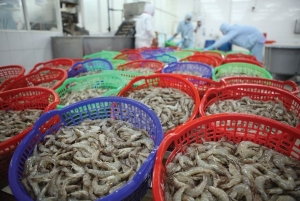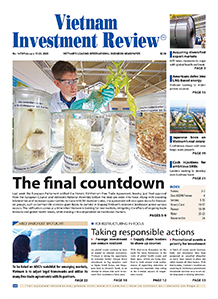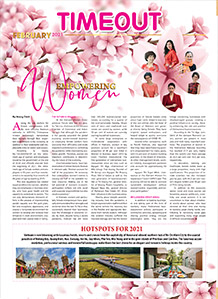Exporters brace for next US administration’s policies
The Ministry of Industry and Trade (MoIT) last week reported that in the first 11 months of 2024, Vietnam’s total export turnover from the US hit $108.9 billion, up nearly 24 per cent on-year, making the US the country’s largest export market.
It is estimated that the whole-year figure may reach $119.7 billion, accounting for 29.5 per cent of Vietnam’s total export turnover, and representing an on-year rise of 23.4 per cent as compared to 2023 when the figure declined by 11.3 per cent.
 |
| Exporters brace for next US administration’s policies |
Vietnam’s total exports to the US include agro-forestry-fishery products, garments and textiles, footwear, and electronics.
The MoIT is hoping that Vietnam will gain $125-130 billion from exports to the US market in 2025. However, it is taking a cautious stance, saying it will have to continue closely and timely monitoring all developments in the US market, especially abrupt changes in US trade policies.
“This is aimed at providing exact information for all goods associations and enterprises in Vietnam, helping them take the initiative in formulating appropriate production and export plans to the US,” the ministry said.
Donald Trump will re-enter the White House on January 20, and one of his hallmark proposals is a universal tariff policy designed to boost domestic production and protect American jobs.
The anticipated policy includes a 20 per cent tariff on all imports, encouraging businesses to shift supply chains back to the US and reducing reliance on foreign goods. Moreover, there will be a more aggressive 60 per cent tariff on Chinese imports, targeting trade imbalances and intellectual property theft to safeguard American innovation.
At a seminar on Vietnam’s outlook for exports to the US in 2025 organised in late December by the MoIT’s European-American Market Department, Do Ngoc Hung, trade counsellor and head of the Vietnam Trade Office in the US, said that the US administration may further boost trade protectionism, with a rise in trade defence measures, and even reverse the country’s trade policies.
In September, the US Department of Commerce launched anti-dumping and countervailing duty investigations on corrosion-resistant steel imported from Vietnam. This petition targets specific types of steel classified and is part of a broader investigation that includes 10 markets, including Vietnam.
According to the MoIT’s Trade Remedies Authority of Vietnam, Vietnam ranked third among the countries under investigation, with corrosion-resistant steel exports to the US totalling $626 million in 2021, $751 million in 2022, and $242 million in 2023.
In 2024, Vietnam’s exports to the US faced 10 trade defence investigation cases like this, and according to Hung, the situation may be more complicated in 2025 as the US will likely use new tools including import tariff increases.
Economist Nguyen Chi Hieu said the new tariff measures would affect the Vietnamese economy. “Tariff hikes will cause difficulties for Vietnam’s exports in the US market, especially items, materials, and components imported from China. They will even be imposed anti-dumping taxes by the US,” Hieu said. “Aquatic products like basa fish, textiles and garments, footwear, and wooden products will be affected the most.”
Fitch Solutions also assessed that the new US administration will cast a shadow on Vietnam’s export-driven growth path, particularly if tariffs are hiked.
“What is certain is that the more protectionist stance Trump has promised to adopt is negative for Vietnam, which has an export-driven economy integrated into the global supply chain. The US is a major trade partner, absorbing 30 per cent of Vietnamese exports,” Fitch Solutions said.
Adam Sitkoff, executive director of the American Chamber of Commerce in Hanoi, told VIR that while some administrative procedures in Vietnam had been eliminated, new laws and regulations continue to be introduced. “For example, foreign investors face delays in approval procedures and time-consuming administrative burdens which hinder or stall their projects and impact Vietnam’s competitiveness,” Sitkoff said.
“Timely approvals are needed for site master plans and related permits, business licences, investments, real estate development, visas for foreign workers, as well as reliable and consistent use of e-government and e-approvals.”
| We believe bilateral tariffs on Vietnam are not Donald Trump’s top priority in its tariff strategy. Most likely, China will be the primary focus, giving Vietnam some leeway to prepare. Additionally, considering that Vietnam’s major export products, machinery and electronics, are part of US allies’ supply chain, it is unlikely that tariffs will be imposed on such products. Instead, the US is likely imposing tariffs on Vietnamese products that have limited links to global supply chains and yet represent a relatively high share in overall US imports. For example, Vietnam is the sixth-largest exporter of wood and timber to the US, could be at risk. During Trump’s first term, the US investigated potential tariffs on Vietnamese timber, justifying that some timber inputs were illegally harvested or traded. Another category at risk, which is more impactful for Vietnam’s economy, is clothing, as Vietnam is the second-largest exporter of clothes to the US, after China. Clothes are relatively substitutable with products from other major producers, notably India, Bangladesh, and Indonesia. If the US imposes tariffs on both China and Vietnam, Vietnam would lose market share, significantly dragging its overall exports and GDP, especially since the textile industry accounts for 14 per cent of total GDP and textile exports to the US comprise about 40 per cent of Vietnam’s textile exports. Currently, Vietnam’s manufacturing sectors are highly reliant on inputs from China. According to the Asian Development Bank’s cross-region input-output data, Chinese inputs make up 25 per cent of the value of electronics and textile production and 14 per cent of machinery production, and up to nearly half of these products are US-bound. More broadly, we estimate that the value of Chinese inputs is equal to around 20 per cent of Vietnam’s exports to the US.Source: Fitch Solutions |
 | Monetary and credit policies supporting exporters Loosening monetary policy and credit incentive packages are aimed at easing exchange rate pressures and supporting exporters during the festive period and year ahead. |
 | Seafood sector anticipates boost in exports The election of former US president Donald Trump as US President is anticipated to be a mixed bag for Vietnam's seafood exports, with Trump's tentative plans to impose a 10-20 per cent tariff on all imports and a 60 per cent tariff on Chinese goods in particular. Experts, however, believe the advantages outweigh the challenges. |
 | Vietnamese passion fruit to break into US market Passion fruit will become the ninth Vietnamese fruit to receive permission to enter the US market, following dragon fruit, mango, longan, lychee, rambutan, star apple, pomelo, and coconut. |
What the stars mean:
★ Poor ★ ★ Promising ★★★ Good ★★★★ Very good ★★★★★ Exceptional
Related Contents
Latest News
More News
- Tien Phong strives for a greener plastics industry (December 02, 2025 | 09:22)
- Czech enterprises strengthen presence (December 01, 2025 | 18:00)
- New phase launched to support women-led ventures (December 01, 2025 | 15:08)
- Airlines race to patch Airbus A320/A321 fleets (December 01, 2025 | 09:17)
- European expertise to boost Vietnam’s sustainable logistics push (November 29, 2025 | 10:00)
- AkzoNobel: from painting walls to painting the future (November 28, 2025 | 13:31)
- Tien Phong Plastic ready for a new growth cycle (November 28, 2025 | 10:56)
- AEON Vietnam charts ambitious growth path (November 28, 2025 | 10:53)
- Carlsberg Vietnam accelerates drive towards net-zero emissions (November 27, 2025 | 19:06)
- Green manufacturing insights and transformations: SABECO’s path to industry leadership (November 27, 2025 | 14:35)

 Tag:
Tag:




















 Mobile Version
Mobile Version